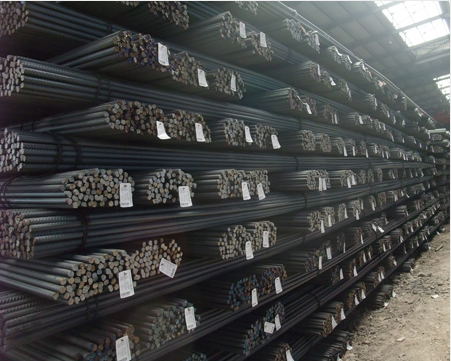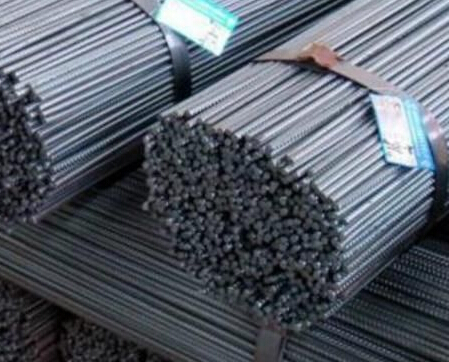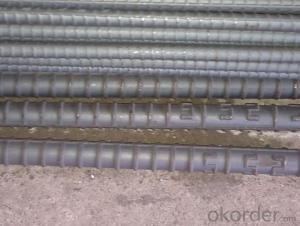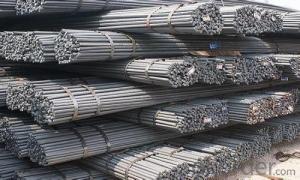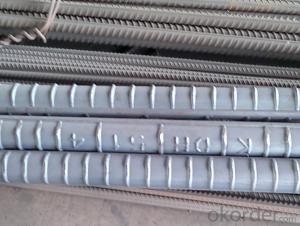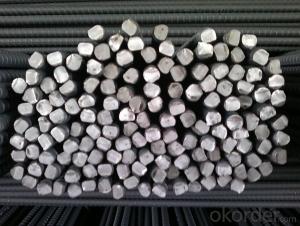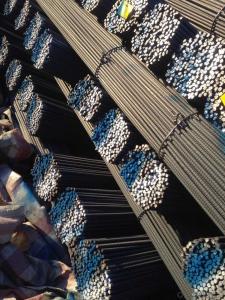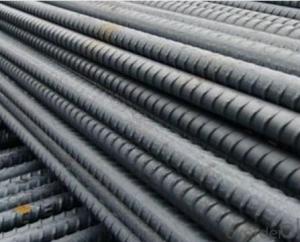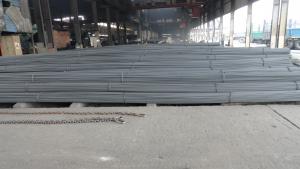Stainless Hot Rolled Steel Rebar with Standard GB,UK,USA
- Loading Port:
- China Main Port
- Payment Terms:
- TT or LC
- Min Order Qty:
- -
- Supply Capability:
- -
OKorder Service Pledge
OKorder Financial Service
You Might Also Like
Product Description:
OKorder is offering Stainless Hot Rolled Steel Rebar with Standard GB,UK,USA at great prices with worldwide shipping. Our supplier is a world-class manufacturer of steel, with our products utilized the world over. OKorder annually supplies products to European, North American and Asian markets. We provide quotations within 24 hours of receiving an inquiry and guarantee competitive prices.
Product Applications:
Stainless Hot Rolled Steel Rebar with Standard GB,UK,USA are ideal for structural applications and are widely used in the construction of buildings and bridges, and the manufacturing, petrochemical, and transportation industries.
Product Advantages:
OKorder's Stainless Hot Rolled Steel Rebar with Standard GB,UK,USA are durable, strong, and resist corrosion.
Main Product Features:
· Premium quality
· Prompt delivery & seaworthy packing (30 days after receiving deposit)
· Corrosion resistance
· Can be recycled and reused
· Mill test certification
· Professional Service
· Competitive pricing
Specifications of Stainless Hot Rolled Steel Rebar with Standard GB,UK,USA:
Standard | GB UK USA | HRB335 HRB400 HRB500 G460B, B500A, B500B,B500C GR40, GR60 | |
Diameter | 6mm,8mm,10mm,12mm,14mm,16mm,18mm,20mm, 22mm,25mm,28mm,32mm,36mm,40mm,50mm | ||
Length | 6M, 9M,12M or as required | ||
Price | Keep lower operating costs so as to offer competitive price for our clients | ||
Delivery Detail | within 45 days after received advanced payment or LC. | ||
Application | mainly used in construction industry to reinforce concrete structures and so on | ||
Invoicing | Actual or Theoretical Weight Basis as buyer’s request. | ||
Type | Hot rolled steel rebar | ||
Brand name | DRAGON | ||
Theoretical weight and section area of each diameter as below for your information:
Diameter(mm) | Section area (mm²) | Mass(kg/m) | Weight of 12m (kg) | Pcs/ton |
6 | 28.27 | 0.222 | 2.664 | 375.38 |
8 | 50.27 | 0.395 | 4.74 | 210.97 |
10 | 78.54 | 0.617 | 7.404 | 135.06 |
12 | 113.1 | 0.888 | 10.656 | 93.84 |
14 | 153.9 | 1.21 | 14.52 | 68.87 |
16 | 201.1 | 1.58 | 18.96 | 52.74 |
18 | 254.5 | 2.00 | 24 | 41.67 |
20 | 314.2 | 2.47 | 29.64 | 33.74 |
22 | 380.1 | 2.98 | 35.76 | 27.96 |
25 | 490.9 | 3.85 | 46.2 | 21.65 |
28 | 615.8 | 4.83 | 57.96 | 17.25 |
32 | 804.2 | 6.31 | 75.72 | 13.21 |
36 | 1018 | 7.99 | 98.88 | 10.43 |
40 | 1257 | 9.87 | 118.44 | 8.44 |
50 | 1964 | 15.42 | 185.04 | 5.40 |
The production process of Stainless Hot Rolled Steel Rebar with Standard GB,UK,USA
1-Waling beam furnace 2-Roughing rolling group 3-Intermediate rolling train
4-Finishing rolling group 5-Water-cooling device 6-Walking beam cooler
7-Finishing equipment(including the cold scale shear,short feet collection system,
automatic counting device,bundling machine, collect bench)
Usage and Applications of Stainless Hot Rolled Steel Rebar with Standard GB,UK,USA:
Deformed bar is widely used in buildings, bridges, roads and other engineering construction. Big to highways, railways, bridges, culverts, tunnels, public facilities such as flood control, dam, small to housing construction, beam, column, wall and the foundation of the plate, deformed bar is an integral structure material. With the development of world economy and the vigorous development of infrastructure construction, real estate, the demand for deformed bar will be larger and larger..
Packaging & Delivery of Hot Rolled Steel Rebar:
Packaging Detail: products are packed in bundle and then shipped by container or bulk vessel, deformed bar is usually naked strapping delivery, when storing, please pay attention to moisture proof. The performance of rust will produce adverse effect.
Each bundle weight: 2-3MT, or as required
Payment terms: TT payment in advance or Irrevocable LC at sight.
Trade terms :FOB, CFR, CIF
Label:to be specified by customer, generally, each bundle has 1-2 labels
Note:
1. Our products are produced according to national standard (GB), if not, supply according to national standards (GB) or agreement as customer required.
2. Other Grade and Standard Deformed Steel Bar we can supply:
Grade: GR40/GR60, G460B/B500A/B500B/B500C,BST500S
Standard: ASTM, BS, DIN
The Minimum Order Quantity of these products is high, and need to be confirmed.
3. We can not only supply Deformed Steel Bar; if you need anything about building materials, please contact us for further information.
4. Please send us your detail specifications when inquire. We will reply to you as soon as possible. We sincerely hope we can establish a long stable business relationship.
FAQ:
Q1: Why buy Materials & Equipment from OKorder.com?
A1: All products offered byOKorder.com are carefully selected from China's most reliable manufacturing enterprises. Through its ISO certifications, OKorder.com adheres to the highest standards and a commitment to supply chain safety and customer satisfaction.
Q2: How do we guarantee the quality of our products?
A2: We have established an advanced quality management system which conducts strict quality tests at every step, from raw materials to the final product. At the same time, we provide extensive follow-up service assurances as required.
Q3: How soon can we receive the product after purchase?
A3: Within three days of placing an order, we will begin production. The specific shipping date is dependent upon international and government factors, but is typically 7 to 10 workdays.
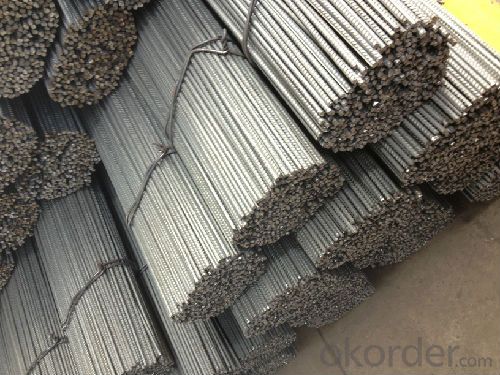

- Q: Can steel rebars be used for both residential and commercial construction?
- Yes, steel rebars can be used for both residential and commercial construction. Steel rebars are commonly used as reinforcement in concrete structures to provide additional strength and stability. They are suitable for various construction projects, including residential buildings, commercial buildings, bridges, and infrastructure projects. The use of steel rebars ensures that the concrete structure can withstand heavy loads, seismic activity, and other external forces. Whether it is a small residential house or a large commercial complex, steel rebars are a reliable and commonly used material for reinforcing concrete structures in both residential and commercial construction.
- Q: What is the purpose of using steel rebars in concrete structures?
- To enhance the overall strength and durability of concrete structures, steel rebars are employed. While concrete excels in compression, it lacks strength in tension. By integrating steel rebars into the concrete, the structure becomes capable of withstanding tensile forces and averting cracking or failure. Typically crafted from carbon steel, steel rebars possess robustness and high tensile strength. They are positioned within the concrete molds prior to pouring, thereby creating a reinforced concrete structure. When exposed to tensile forces, the concrete transfers the load to the steel rebars, which can effectively endure the stretching or pulling forces. This reinforcement aids in the equitable distribution of the load, warding off localized stress points and diminishing the likelihood of structural failure. In addition to providing tensile strength, steel rebars also assist in managing cracks in concrete structures. As concrete contracts and expands due to temperature fluctuations or drying, it becomes susceptible to cracking. The inclusion of steel rebars curbs the width and extent of these cracks, guaranteeing the structural integrity and prolonged lifespan of the concrete. Moreover, steel rebars heighten the resistance of concrete structures to seismic activity or other dynamic forces. The malleability of steel rebars enables them to absorb and dissipate energy during earthquakes or vibrations, thereby diminishing the risk of collapse. In essence, the purpose of incorporating steel rebars into concrete structures is to fortify and reinforce the concrete. This entails providing additional tensile strength, managing cracks, and augmenting the overall durability and resilience of the structure.
- Q: What is the effect of high temperatures on steel rebars?
- Steel rebars are significantly affected by high temperatures. When exposed to high temperatures, steel rebars undergo thermal expansion, causing them to increase in size. This expansion can cause cracks or spalling in the surrounding concrete as the larger rebars exert pressure on it. Moreover, high temperatures can weaken and reduce the load-bearing capacity of steel rebars. This weakening phenomenon, known as tempering, occurs when heat compromises the structural integrity of the steel, making it less strong. Consequently, steel rebars exposed to high temperatures may experience reduced strength and become more prone to deformation or failure. Therefore, when designing structures or assessing their integrity, it is crucial to consider the impact of high temperatures on steel rebars, particularly in environments susceptible to heat or fire hazards.
- Q: How do steel rebars contribute to the crack-resistance of concrete?
- Crucial in improving the crack-resistance of concrete structures are steel rebars, also known as reinforcement bars. These rebars serve as a reinforcement system when embedded within concrete, aiding in the distribution and resistance of tensile forces. This is particularly important due to the relatively low tensile strength of concrete, despite its high compressive strength. The absorption of tensile stresses is the primary means by which rebars contribute to crack-resistance. Without rebars, these stresses would lead to the development of cracks in the concrete. By bearing the tension forces as the load is applied to the structure, the rebars prevent excessive tensile stress and subsequent cracking. This is especially crucial in areas subjected to bending or flexing forces. Additionally, the bond strength between the rebars and the surrounding concrete plays a role in crack-resistance. The presence of rebars improves this bond, preventing the separation or debonding of the concrete under stress. This ensures effective load transfer between the rebars and the concrete, further reducing the likelihood of cracks. Furthermore, steel rebars aid in controlling crack widths in concrete. Acting as a restraint when tensile forces are applied, the rebars limit the width of any cracks that may form. This prevents the cracks from widening and becoming more severe, preserving the overall integrity and durability of the structure. To summarize, steel rebars play a significant role in enhancing the crack-resistance of concrete by absorbing tensile stresses, improving bond strength, and controlling crack widths. Their presence within the concrete structure aids in the distribution and resistance of forces, preventing the formation of cracks and ensuring the longevity and safety of the construction.
- Q: What are the guidelines for the proper storage of steel rebars on construction sites?
- Proper storage of steel rebars is crucial on construction sites to ensure their integrity and prevent any potential hazards. Here are some guidelines for the correct storage of steel rebars: 1. Select a suitable storage area: Choose a flat, stable, and well-drained area for storing steel rebars. Avoid locations prone to flooding or excessive moisture. 2. Provide adequate space: Allow enough space between rebars to prevent any contact or entanglement that may cause damage. Maintain clear aisles and paths for easy access and movement. 3. Protect against corrosion: Steel rebars should be protected from moisture and corrosion. Cover them with waterproof and UV-resistant tarpaulins or plastic sheets to shield them from rain, snow, or direct sunlight. 4. Elevate from the ground: Place the rebars on wooden supports or pallets to keep them off the ground. This prevents contact with water, dirt, or any other contaminants that could accelerate corrosion. 5. Securely stack rebars: Stack the rebars horizontally in a way that ensures stability and prevents them from rolling or falling. Place larger and heavier rebars at the bottom of the stack to provide a secure base. 6. Label and organize: Clearly label each stack with information such as size, length, and grade for easy identification. Organize the storage area by separating different sizes or types of rebars to minimize confusion and facilitate retrieval. 7. Regularly inspect and maintain: Conduct routine inspections to check for any signs of corrosion, damage, or deformation. Remove any rebars that show signs of deterioration to prevent accidents or compromised structural integrity. 8. Handle with care: When moving or transporting rebars, use appropriate lifting equipment like cranes, forklifts, or hoists. Avoid dragging or dropping them, as this can cause deformation or damage. 9. Follow manufacturer's recommendations: Consult the manufacturer's guidelines for specific storage requirements and recommended practices for the particular type of steel rebars being used. By following these guidelines, construction sites can ensure the proper storage of steel rebars, which in turn helps maintain their quality, prolong their lifespan, and guarantee the safety of workers and structures.
- Q: Are steel rebars susceptible to rust?
- Yes, steel rebars are susceptible to rust.
- Q: What is the role of steel rebars in beam and column design?
- The role of steel rebars in beam and column design is crucial, as they serve to reinforce and enhance the structural integrity of these elements. In reinforced concrete structures, rebars are utilized to withstand tensile forces that concrete alone is unable to bear. When it comes to beams, it is common practice to position rebars at the bottom to counteract the tensile stresses caused by bending moments. By distributing the load along the length of the beam, rebars effectively bolster its strength and prevent the occurrence of cracks or failures. The tension-resisting ability of rebars is instrumental in maintaining the beam's shape and its capacity to bear loads, thereby ensuring the overall stability of the entire construction. Similarly, in columns, rebars are placed throughout their length to withstand both axial and bending forces. They enhance the column's capacity to endure compression, while simultaneously offering additional resistance against lateral loads from seismic or wind forces. The presence of rebars in columns significantly amplifies their load-bearing capability and overall stability. To summarize, steel rebars play a pivotal role in beam and column design by providing reinforcement against tensile forces, augmenting structural strength, averting cracks, and guaranteeing the overall stability and safety of the structure.
- Q: What is the role of steel rebars in minimizing cracking due to shrinkage?
- The role of steel rebars in minimizing cracking due to shrinkage is to provide reinforcement and strength to concrete structures. By placing steel rebars within the concrete, they act as a framework that helps distribute the tensile forces caused by shrinkage. This prevents the concrete from cracking and ensures the overall stability and durability of the structure.
- Q: What are the different types of steel rebars used in industrial constructions?
- Industrial constructions commonly utilize various types of steel rebars, which play a crucial role in reinforcing concrete structures and imparting strength and durability to the overall construction. The key types of steel rebars frequently employed in industrial constructions are as follows: 1. Mild Steel Rebars, also referred to as black steel rebars, are the most prevalent type utilized in construction. These rebars, crafted from carbon steel, possess a smooth surface. They offer adequate strength and are cost-effective, rendering them suitable for a diverse range of industrial applications. 2. High-strength Deformed Steel Rebars (HSD) exhibit ribs or deformations on their surface, enhancing their bonding with concrete. HSD rebars, composed of carbon steel, undergo thermomechanical treatment to enhance their strength. They are commonly employed in heavy-duty industrial constructions requiring higher strength. 3. Epoxy-coated Rebars are coated with an epoxy resin to safeguard them against corrosion. These rebars find common usage in areas where concrete is exposed to moisture or chemicals, such as bridges and marine structures. The epoxy coating functions as a barrier, averting corrosion and prolonging the structure's lifespan. 4. Galvanized Rebars encompass a layer of zinc coating, bestowing them with corrosion resistance. The zinc coating acts as a sacrificial layer, shielding the steel rebars from rust. These rebars are frequently employed in areas where concrete is exposed to harsh environmental conditions or in coastal regions where the risk of corrosion is elevated. 5. Stainless Steel Rebars, recognized for their exceptional corrosion resistance, are utilized in environments necessitating remarkable durability and resistance to corrosion. They commonly find application in industrial constructions exposed to aggressive chemicals, high humidity, or extreme temperatures. Each type of steel rebar possesses distinct advantages and is suitable for diverse applications based on the specific requirements of the industrial construction project. It is imperative to meticulously consider factors such as strength, corrosion resistance, and cost when selecting the apt type of steel rebar for a particular construction endeavor.
- Q: Are there any limitations on using steel rebars in cold climates?
- Yes, there are some limitations on using steel rebars in cold climates. The main concern is the potential for corrosion due to the presence of moisture, salt, and de-icing chemicals commonly used on roads and bridges during winter. When steel rebars are exposed to these elements, they can rust and weaken over time, compromising the structural integrity of the concrete. To mitigate this issue, several measures can be taken. One common practice is to use epoxy-coated rebars, which provide a protective layer against moisture and chemicals. Additionally, stainless steel rebars can be used, as they are highly resistant to corrosion. However, these options can be more expensive than traditional steel rebars. Furthermore, the construction process in cold climates can also present challenges. Concrete cures and gains strength more slowly in low temperatures, which can impact the overall project timeline. Special precautions, such as heating the concrete or using accelerators, may be necessary to ensure proper curing. It is important to consult local building codes and regulations specific to cold climates to ensure compliance and safety. Engineering professionals experienced in cold weather construction practices can provide valuable insights and recommendations to address the limitations associated with using steel rebars in these conditions.
Send your message to us
Stainless Hot Rolled Steel Rebar with Standard GB,UK,USA
- Loading Port:
- China Main Port
- Payment Terms:
- TT or LC
- Min Order Qty:
- -
- Supply Capability:
- -
OKorder Service Pledge
OKorder Financial Service
Similar products
Hot products
Hot Searches
Related keywords




